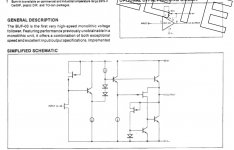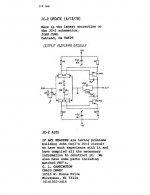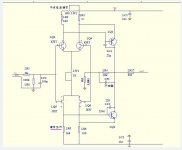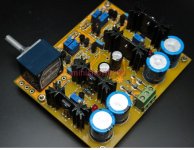The input bias current has to flow through the resistor you connect to the TZ. So if that's say 2k then it'll give worst case an additional 4mV offset (2uA * 2kohms). In the scheme of things though this effect is swamped by the buffer's offset voltage which could be as bad as 60mV.
having 6 designs here that use it, including some low noise regulators, as well as the 610 and a rack of 600 waiting for other projects. I have some experience of these chips too over the last 3 years or so. I'm also pulling from opc's experience with it. I reckon hes studied this chip closer than just about anyone, with full AP and HP test gear and has had thousands pass through his hands.
the offset can be much worse with bad cable routing, stray pickup from nearby clocks etc. I have had as bad as a couple hundred mV on the bench with lazy wiring (and several volts with the input open) if you dont need the WBW mode, dont use it. bare in mind that you can also adjust the BW by using a resistor from the neg rail VEE- >BW pin, rather than a short.
the 610's only advantage is higher voltage rail capability, otherwise it is effectively identical.
all that being said, with everything in place, offset can be low enough to be inconsequential. its an excellent chip, I much prefer it to the BUF634T. all but one of the times i've used it have been open loop
the offset can be much worse with bad cable routing, stray pickup from nearby clocks etc. I have had as bad as a couple hundred mV on the bench with lazy wiring (and several volts with the input open) if you dont need the WBW mode, dont use it. bare in mind that you can also adjust the BW by using a resistor from the neg rail VEE- >BW pin, rather than a short.
the 610's only advantage is higher voltage rail capability, otherwise it is effectively identical.
all that being said, with everything in place, offset can be low enough to be inconsequential. its an excellent chip, I much prefer it to the BUF634T. all but one of the times i've used it have been open loop
Last edited:
I did not understand which version gave the best result of sound. You use two AD844 per channel, one for i/v with out at pin 5 and second for output buffer in combination as a classic op? Or use only one AD and discrete buffer? With feedback or without?
I read in previous posts that i can use AD844 for PCM1794. Output current for PCM1794 is 8mA or in mono mode 16mA, but input inverting current for AD is 5mA.
Does anybody compare the sound SEN, CEN, AD844 and D1?
I came into possession pcm63p-ky and I want to use them in the best sound version but would like to clarify and other situations like PCM1794.
I read in previous posts that i can use AD844 for PCM1794. Output current for PCM1794 is 8mA or in mono mode 16mA, but input inverting current for AD is 5mA.
Does anybody compare the sound SEN, CEN, AD844 and D1?
I came into possession pcm63p-ky and I want to use them in the best sound version but would like to clarify and other situations like PCM1794.
I did not understand which version gave the best result of sound. You use two AD844 per channel, one for i/v with out at pin 5 and second for output buffer in combination as a classic op? Or use only one AD and discrete buffer? With feedback or without?
So far using the PCM1704 (1.2mA) the best resut i got was open loop (no feedback) TZ resistor 4.7kohms with 470pf 2 x stacked ad844's stacking only the I/V stage pins 2 3 4 5 and 7 then using only one buffer section by comming off one only AD844 pin 6.
I read in previous posts that i can use AD844 for PCM1794. Output current for PCM1794 is 8mA or in mono mode 16mA, but input inverting current for AD is 5mA.
Never tried this, but with 8mA you'll to stack at least up to 6 to stop current starvation.
Does anybody compare the sound SEN, CEN, AD844 and D1?
Not me.
I came into possession pcm63p-ky and I want to use them in the best sound version but would like to clarify and other situations like PCM1794.
PCM63 has 2mA so 3 stacked will maybe be needed Cheers George
The input bias current has to flow through the resistor you connect to the TZ. So if that's say 2k then it'll give worst case an additional 4mV offset (2uA * 2kohms). In the scheme of things though this effect is swamped by the buffer's offset voltage which could be as bad as 60mV.
You were right abraxilito, got the LME49600's today put them in and bang on 60mV dc offset, too much for me.
Is there a ready made buffer that would do the same performance as the LME49600 but that has fet input so the dc offset won't be so much of a problem? Why does the AD844's internal buffer have almost zero dc offset the way I've used it, as it is all bi-polar? looks as though it's the winner.
Cheers George
Hi george,
can this AD844 be used as a simple I/V convertor without any gain at all?
I mean, what value has to be the pin5 resistor to ground so that I can use an usual tube amplification/buffer combination that I am presently using? the idea is to make AD844 to work only as I/V with no amplification at all so that it replaces ONLY my current passive I/V resistor; I remember reading somewhere that with values above 50 ohm, the resistor on pin5 (to GND) will be starting to impose gain; anyone tried this, would this be possible ? what advantage might be (at least in theory) to make AD844 act only as I/V, replacing a quality passive resistor? is it worth it?
can this AD844 be used as a simple I/V convertor without any gain at all?
I mean, what value has to be the pin5 resistor to ground so that I can use an usual tube amplification/buffer combination that I am presently using? the idea is to make AD844 to work only as I/V with no amplification at all so that it replaces ONLY my current passive I/V resistor; I remember reading somewhere that with values above 50 ohm, the resistor on pin5 (to GND) will be starting to impose gain; anyone tried this, would this be possible ? what advantage might be (at least in theory) to make AD844 act only as I/V, replacing a quality passive resistor? is it worth it?
luxury54 with i/v resistor must use small value of resistor to keep current output of the dac at working voltage value, followed by voltage amplifier with high gain. With AD844 you already have voltage amplifier and only need buffer. If you use the same value resistor at pin 5 you have the same situation like only i/v resistor
thanks, that's what I wanted to know! it is more useful with DACS like PCM1798 which have differential output so both phases can be used and let AD844 act just as a simple I/V resistor, in contrast with the classic method of taking just the ( - ) phase to the tube's grid when using a passive resistor
I am very happy with just using one internal buffer with the stacked pair of AD844's but I'd like to try other things. The LME49600/LME49610 would have maybe been a good thing but it was a no go because of the 60mv dc offset and I don't like coupling caps.
So I searched everywhere for a fet input bi-polar output buffer that could suit, the only thing I could find was the old BUF03 which has been obsolete for some time now, does anyone know where I can get a pair of originals of these somewhere? So I can compare it to the internal buffer of the AD844?
Cheers George
So I searched everywhere for a fet input bi-polar output buffer that could suit, the only thing I could find was the old BUF03 which has been obsolete for some time now, does anyone know where I can get a pair of originals of these somewhere? So I can compare it to the internal buffer of the AD844?
Cheers George
I am very happy with just using one internal buffer with the stacked pair of AD844's but I'd like to try other things. The LME49600/LME49610 would have maybe been a good thing but it was a no go because of the 60mv dc offset and I don't like coupling caps.
So I searched everywhere for a fet input bi-polar output buffer that could suit, the only thing I could find was the old BUF03 which has been obsolete for some time now, does anyone know where I can get a pair of originals of these somewhere? So I can compare it to the internal buffer of the AD844?
Cheers George
Is it too hard to design a discrete buffer with jFET input?
Is it too hard to design a discrete buffer with jFET input?
They did it with the BUF03 and that was some 20 years ago and they even had a dc offset null pins on it, they must be able to do today and even better, I just can't understand it. Dirk by any chance do you have some BUF03's in your stash?
Cheers George
Attachments
There is a discrete one on ebay that's cheap, it a clone of the JC-2 I believe that John Curl designed for Mark Levinson preamp output buffer. And it has power supply attached as well What do you guys think of this circuit? Are the bi-bipolars the output?
Cheers George
Cheers George
Attachments
Last edited:
BUF03's
Hi George, PM me.... I have a source for BUF03's. A wonderful chip for driving headphones.
A wonderful chip for driving headphones.
I am very happy with just using one internal buffer with the stacked pair of AD844's but I'd like to try other things. The LME49600/LME49610 would have maybe been a good thing but it was a no go because of the 60mv dc offset and I don't like coupling caps.
So I searched everywhere for a fet input bi-polar output buffer that could suit, the only thing I could find was the old BUF03 which has been obsolete for some time now, does anyone know where I can get a pair of originals of these somewhere? So I can compare it to the internal buffer of the AD844?
Cheers George
Hi George, PM me.... I have a source for BUF03's.
LH0033 and LH0063 have FET input, but are obsolete too.
63 looks cute.
Just looked at the data sheet, they are beasts, you could drive some horns with those, a little too high on the distortion .1%. They are on ebay $10 for the 0033 but way overkill for this aplication.
Cheers George
They did it with the BUF03 and that was some 20 years ago and they even had a dc offset null pins on it, they must be able to do today and even better, I just can't understand it. Dirk by any chance do you have some BUF03's in your stash?
Cheers George
eBay is your friend on this one:
buf03 | eBay
I am very happy with just using one internal buffer with the stacked pair of AD844's but I'd like to try other things. The LME49600/LME49610 would have maybe been a good thing but it was a no go because of the 60mv dc offset and I don't like coupling caps.
So I searched everywhere for a fet input bi-polar output buffer that could suit, the only thing I could find was the old BUF03 which has been obsolete for some time now, does anyone know where I can get a pair of originals of these somewhere? So I can compare it to the internal buffer of the AD844?
Cheers George
Did you consider a servo to eliminate the DC offset?
- Home
- Source & Line
- Digital Line Level
- Using the AD844 as an I/V



